
a) i) In recent years growth and complexity of financial instruments has been quite significant. Companies use a range of instruments to transform and manage their financial risk. However, accounting standards have not developed at the same rate as the growth in the instruments. The main concern for standard setters is that many derivatives may not be recognized in statement of financial position. The main reason for this is the use of the historical cost concept in financial statements together with the fact that many derivatives have a nil cost. However, derivatives may be substantial assets and liabilities and may expose the entity to significant risk. Additionally many companies measure financial assets at amortized cost even though there are reliable quoted market prices that differ from amortized cost and the assets are readily sale able.
Until IAS 39 Financial instruments: recognition and measurement unrealized gains and losses arising from changes in the value of many financial instruments were often ignored. Unrealized losses were recognized if the instrument was valued on the basis of lower of cost or market value but ignored if the instrument was classed as a hedge. The danger is that such unrealized losses may be overlooked. Additionally companies could choose when they recognized profits on instruments in order that they could smooth profits. This applied both to derivatives and non-derivatives.
The use of hedge accounting caused significant problems.
The practical problem with hedge accounting is translating business decisions into an accounting transaction that satisfies the hedging criteria. Hedge accounting relies on management intent and the result of this is that identical instruments can be accounted for differently depending upon the intentions of management in relation to them. Hedge accounting is often used for hedges of un constructed future transactions and in these circumstances can be used to justify deferring almost any gain or loss on the derivative.
Circumstances can change quickly in the financial markets and the resultant effect on a company’s derivatives can quickly transform the risk profile of a company. The accounting framework did not adequately make this movement in the position and risk apparent to users of financial statements.
ii) Disclosure of the risk of an entity in relation to financial instruments is an important element of accounting for financial instruments and the IASC developed IAS 32 to deal with this issue. However, disclosure requirements alone are not sufficient to deal with the problem. Recognition and measurement issues need to be dealt with. Many derivatives are kept out of the statement of financial position with unrealized gains and losses being ignored. Hedge accounting problems cannot be dealt with purely by requiring narrative disclosures of the hedging instrument or any amount of the deferred or unrecognized gain or loss. It is important that agreement is achieved over the possible measurement bases which can be used. The use of current values for financial instruments requires agreement as it is critical measurement issue. For example, could current values be used for derivatives but not for non-derivatives? There are issues of impairment of financial instruments and the recognition of such instruments which need to be dealt with in standard. Most issues in accounting are dealt with by standards focusing on measurement, recognition and disclosure issues. A financial instrument is no exception in this regard and it is such an important issue that disclosure alone could never effectively deal with the issues satisfactorily. The IASC issued IAS 39 Financial instruments: recognition and measurement to deal with these issues.
b) Under IAS 39, all financial assets and liabilities are recognized in the statement of financial position and this includes derivatives. They are originally measured at cost which is the fair value of whatever was paid or received to acquire the financial asset or liability. Subsequently, all financial assets are measured to fair value with exception of certain specified items.
Of the financial assets specified in the question, two items will be measured at fair value (sh.6000m and sh.3460m respectively) and one amortized cost. The equity securities and other financial assets held for trading and the derivative assets will be valued at fair value whereas the fixed maturity investments to be held to maturity are one of the categories of items to be carried at amortized cost.
Most financial liabilities are measured at original recorded amount less principal repayments and amortizations. Only derivatives and liabilities held for trading are re-measured to fair value. Thus the redeemable preference shares will remain at the carrying amount (sh.3400).
Both the derivatives and the non-derivatives assets held for trading are categorized as financial assets at fair value through profit or loss. This means that in both cases the gain arising during the period should be recognized in the income statement.
marto answered the question on February 14, 2019 at 06:20
-
IAS 32 'Financial Instruments: Disclosure and Presentation' states that the purpose of the disclosures required by this standard is to provide information that will enhance...
(Solved)
IAS 32 'Financial Instruments: Disclosure and Presentation' states that the purpose of the disclosures required by this standard is to provide information that will enhance understanding of the significance of on-balance-sheet and off-balance-sheet financial instruments to an enterprise’s financial position, performance and cash flow and assist in assessing the amounts, timing and certainty of future cash flows associated with those instruments. State and briefly describe three types of financial risks described in the standard, in relation to transactions in financial instruments.
Date posted:
February 14, 2019
.
Answers (1)
-
With reference to IAS 39(Financial Instruments: Recognition and Measurement), explain how financial instruments are initially recognized and subsequently measured in the books of a reporting...
(Solved)
With reference to IAS 39(Financial Instruments: Recognition and Measurement), explain how financial instruments are initially recognized and subsequently measured in the books of a reporting entity.
Date posted:
February 14, 2019
.
Answers (1)
-
Redline Limited invested in 10% loan stock on 1 November 2007 given a par value of Sh. 20 million. The issuer of the loan stock...
(Solved)
Red line Limited invested in 10% loan stock on 1 November 2007 given a par value of Sh. 20 million. The issuer of the loan stock was Borrow Limited. The loan stock was for five years and is to be settled on 31 October 2012. The loan stock was quoted but Red line Limited was to hold it to maturity. The effective interest rate on 1 November 2007 was 12% and this had not changed over the three years to 31 October 2010.
On 31 October 2010, Borrow Limited, after paying the annual interest, went into financial difficulties and Red line Limited estimated that interest would be received over the remaining two years but only half of the loan stock would be received on maturity. The loan stock was therefore impaired.
Required:
Explain how the loan stock in Borrow Limited will be reported in the financial statements for the year ended 31 October 2010.
Date posted:
February 14, 2019
.
Answers (1)
-
Biz Ltd. invested in the shares of ABC Ltd. and XYZ Ltd. where the two were designated as a hedge based on cash.
The investments were...
(Solved)
Biz Ltd. invested in the shares of ABC Ltd. and XYZ Ltd. where the two were designated as a hedge based on cash.
The investments were made up as follows:
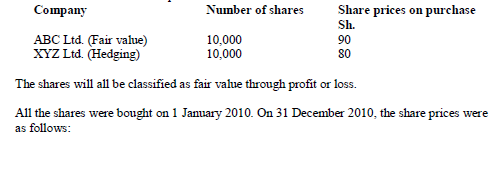
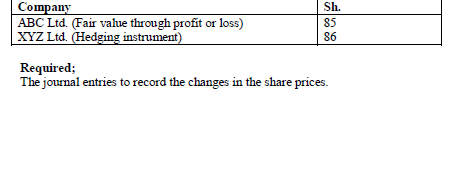
Date posted:
February 14, 2019
.
Answers (1)
-
Explain the three main types of hedge as provided in IAS 39 (Financial Instruments: Recognition and Measurement) and their accounting treatment.
(Solved)
Explain the three main types of hedge as provided in IAS 39 (Financial Instruments: Recognition and Measurement) and their accounting treatment.
Date posted:
February 14, 2019
.
Answers (1)
-
With reference to IAS 37 (Provisions, Contingent Liabilities and Contingent Assets), differentiate between a 'constructive obligation' and a 'contingent liability'.
(Solved)
With reference to IAS 37 (Provisions, Contingent Liabilities and Contingent Assets), differentiate between a 'constructive obligation' and a 'contingent liability'.
Date posted:
February 14, 2019
.
Answers (1)
-
The distinction between a provision and a contingent liability is irrelevant. Discuss.
(Solved)
The distinction between a provision and a contingent liability is irrelevant. Discuss.
Date posted:
February 14, 2019
.
Answers (1)
-
Discuss the approach taken by International Financial Reporting Standard (IFRS) 9 in measuring and classifying financial assets and the main effect that IFRS 9 will...
(Solved)
Discuss the approach taken by International Financial Reporting Standard (IFRS) 9 in measuring and classifying financial assets and the main effect that IFRS 9 will have on accounting for financial assets.
Date posted:
February 14, 2019
.
Answers (1)
-
(a) IAS 16: property, plant and equipment gives certain criteria to be satisfied before an item of property, plant and equipment should be recognized as...
(Solved)
(a) IAS 16: property, plant and equipment gives certain criteria to be satisfied before an item of property, plant and equipment should be recognized as an asset. State these criteria and state the value at which the asset should be measured initially. Give six examples of directly attributable costs that could be included in the value and four examples of cost that should not be included in the value.
(b) Chumuki Supermarket Limited is a quoted company which runs 22 Supermarket stores throughout Kenya. 12 of these stores are situated in and around Nairobi and all 12 are supplied by Chumuki’s central go down situated in the industrial area of Nairobi. Pricing, marketing and human resources policies are decided centrally by Chumuki. All stores are managed in the same way and management run the business on a store-by-store profit basis.
Recently, the Githurai store has seriously under performed against its budget for the year ending 31 December 2000. Rising insecurity in the area together with difficulties in obtaining access to the store have seriously adversely affected its financial performance. The Githurai store together with the Kahawa store were purchased from Ruiru Superstores on 1 January 1998 for Sh.25 million and Sh.25 million and Sh.15 million respectively plus goodwill of Sh.8 million for both stores. The stores are being depreciated on the straightline method to nil residual value over 20 years the goodwill is being amortized to nil on the straight line basis over the same period. The Githurai store could be sold for Sh.15 million net. Its value in use is Sh.20 million. Management have performed a “bottom-up” test in relation to the goodwill and the purchase prices of the stores and are satisfied that a 'top-down' test is not needed.
Required:
State in detail how the impairment loss should be recognized for the Githurai cash-generating unit in the financial Statements for the year ending 31 December 2000: neither depreciation nor amortization has yet been charged for this period. State also the carrying value of the Githurai cash-generating unit after the impairment loss has been recognized. Ignore deferred tax.
Date posted:
February 14, 2019
.
Answers (1)
-
Identify and explain five indicators which show that an impairment loss to a fixed asset may have occurred.
(Solved)
Identify and explain five indicators which show that an impairment loss to a fixed asset may have occurred.
Date posted:
February 14, 2019
.
Answers (1)
-
The following information is provided relating to the carrying amount of the assets comprising the cash generating units of Alexo Ltd as at 30 September...
(Solved)
The following information is provided relating to the carrying amount of the assets comprising the cash generating units of Alexo Ltd as at 30 September 2009:
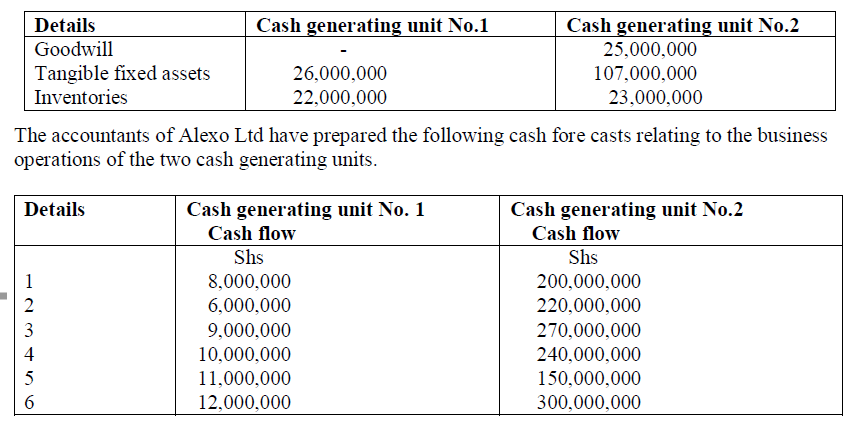
Date posted:
February 14, 2019
.
Answers (1)
-
Briefly explain any three factors that may indicate that a financial asset is impaired.
(Solved)
Briefly explain any three factors that may indicate that a financial asset is impaired.
Date posted:
February 14, 2019
.
Answers (1)
-
International Financial Reporting Standard (IFRS) 6 (Exploration for and Evaluation of Mineral Resources) provides guidance on how tangible and intangible assets used to explore the...
(Solved)
International Financial Reporting Standard (IFRS) 6 (Exploration for and Evaluation of Mineral Resources) provides guidance on how tangible and intangible assets used to explore the existence of mineral resources can be accounted for and presented.
Required
Briefly explain four factors that indicate that such assets have been impaired.
Date posted:
February 14, 2019
.
Answers (1)
-
Explain how an impairment loss is measured according to IAS 36 (Impairment of Assets).
(Solved)
Explain how an impairment loss is measured according to IAS 36 (Impairment of Assets).
Date posted:
February 14, 2019
.
Answers (1)
-
On 1 January 2006, Matopeni Primary School acquired a bus at a cost of Sh.6.000.000 to enable students from a nearby village commute to school...
(Solved)
On 1 January 2006, Matopeni Primary School acquired a bus at a cost of Sh.6.000.000 to enable students from a nearby village commute to school free of charge. The school estimated that the bus had a useful life of 10 years. Or 31 December 2010, the bus sustained damage in a road accident requiring Sh. 1,200.000 to be restored to a usable condition. The restoration did not affect the useful life of the asset. The cost of a new bus to deliver a similar service was Sh.7, 500,000 as at 31 December 2010.
Required:
Evaluate the impairment loss attributable to the bus using the requirements of IPSAS 21 (Impairment of Non-Cash Generating Assets). Use the restoration cost approach.
Date posted:
February 14, 2019
.
Answers (1)
-
With reference to IPSAS 21 (Impairment of Non-Cash Generating Assets), explain the following terms:
i) Government business enterprise
ii) Carrying amount
iii) Recoverable service amount
(Solved)
With reference to IPSAS 21 (Impairment of Non-Cash Generating Assets), explain the following terms:
i) Government business enterprise
ii) Carrying amount
iii) Recoverable service amount
Date posted:
February 14, 2019
.
Answers (1)
-
a) In the context of International Accounting Standard (IAS) 21 (The Effects of Changes in Foreign Exchange Rates), explain two factors that should be considered...
(Solved)
a) In the context of International Accounting Standard (IAS) 21 (The Effects of Changes in Foreign Exchange Rates), explain two factors that should be considered in determining an entity's functional currency.
b) Ufanisi Ltd. is a Kenyan-based company that uses the Kenya Shilling (Ksh) as its presentation currency. On 1 January 2010, the company established a wholly owned
subsidiary, Ng'ambo Ltd., in a foreign country known as Ugenini, In addition to Ufanisi Ltd. making an equity investment in the subsidiary, a long term note payable to an Ugenini bank was negotiated to purchase property and equipment. The currency used in Ugenini is known as the Falanga (Fn). The subsidiary began operations with the following statement of financial position as at 1 January 2010:
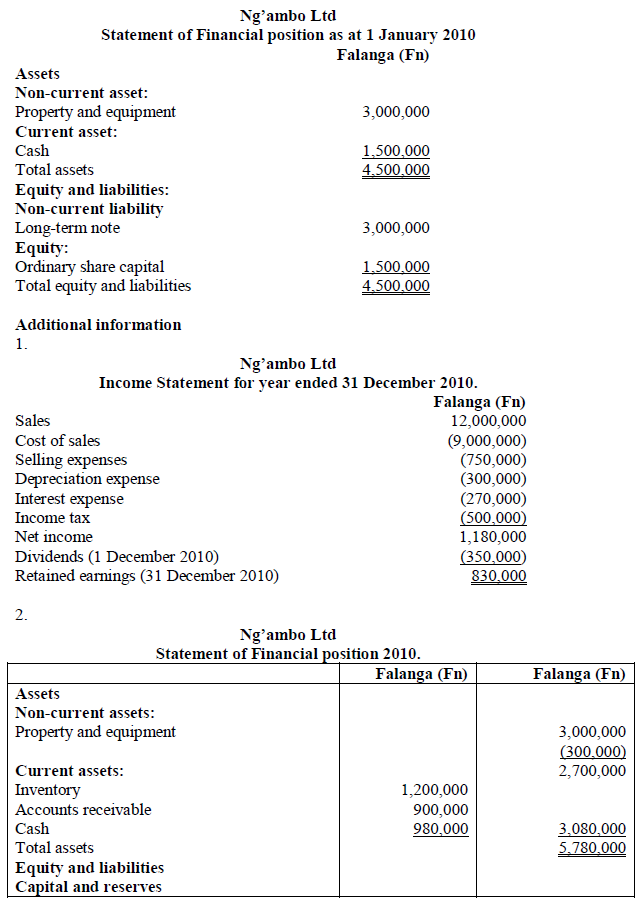
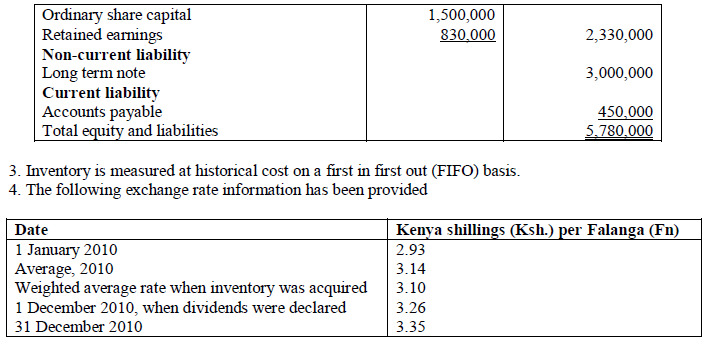
Required:
Translate the following financial statements of Ng'ambo Ltd. using the temporal method:
i) Income statement for the year ended 31 December 2010.
ii) Statement of financial position as at 31 December 2010.
Date posted:
February 13, 2019
.
Answers (1)
-
Halua Ltd., a local company, acquired 75% of the ordinary share capital of Sukari Ltd., a foreign company on 1 May 2008. Sukari Ltd.'s functional...
(Solved)
Halua Ltd., a local company, acquired 75% of the ordinary share capital of Sukari Ltd., a foreign company on 1 May 2008. Sukari Ltd.'s functional currency is the Rupia (Ra).
The following financial statements relate to the two companies for the year ended 30 April 2011:
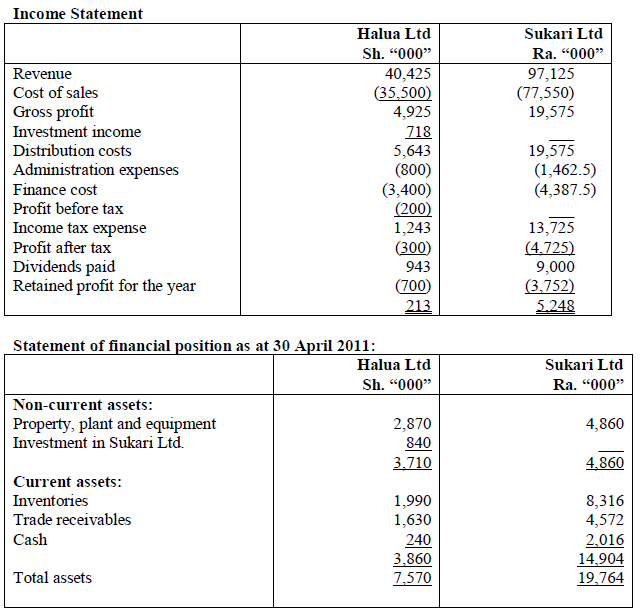
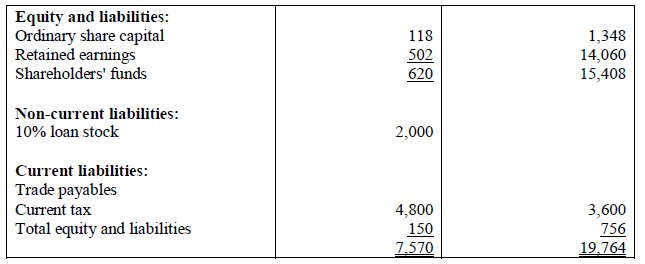
Additional information:
1. Halua Ltd. acquired the shares in Sukari Ltd. when the retained earnings in Sukari Ltd. were Ra 2,876,000.
2. During the year, Halua Ltd. sold goods worth Sh.5 million to Sukari Ltd. and reported a gross profit margin of 20% on selling price. Half of these goods were still in the inventory of Sukari Ltd. as at the year end.
3. Included in the receivables of Halua Ltd. is Sh.500,000 due from Sukari Ltd.
4. The translation differences in the consolidated financial statements at 30 April 2010 relating to the translation of Sukari Ltd. (excluding goodwill) were Sh.208,000. Retained earnings on the same date in Sukari Ltd.'s financial statements in the post-acquisition period as at 30 April 2010 amounted to Sh. 1,372,000.
5. The group uses the partial goodwill method and no impairment loss has been reported so far.
6. The following exchange rates are relevant.

Required:
a) Consolidated income statement for the year ended 30 April 2011.
b) Consolidated statement of changes in equity for the year ended 30 April 2011.
c) Consolidated statement of financial position as at 30 April 2011.
Date posted:
February 13, 2019
.
Answers (1)
-
The following financial statements relate to H Ltd. and its investment companies S Ltd., A Ltd. and J Ltd. for the year ended 30 April...
(Solved)
The following financial statements relate to H Ltd. and its investment companies S Ltd., A Ltd. and J Ltd. for the year ended 30 April 2012:
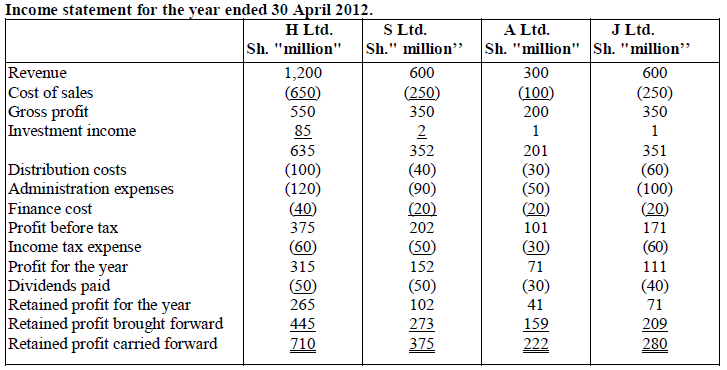
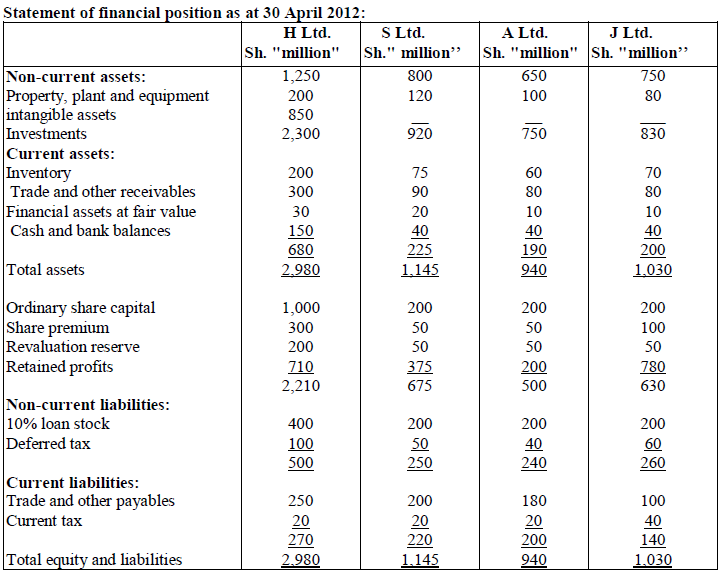
Additional information:
1. H Ltd, acquired the investments in the other companies as follows:

2. The fair value of the non-controlling interest in S Ltd. was Sh.75 million on 1 May 2008.
3. During the year ended 30 April 2012, II Ltd. sold goods lo S Ltd. and A Ltd. as follows:

4. On 1 May 2010, H Ltd. sold S Ltd. an item of plant for Sli.200 million reporting a 25% profit on the initial cost plant. The group charges depreciation at 20% per annum on cost on plant.
5. All the goodwills of the three companies in which H Ltd. has invested are estimated to be impaired by 25% in the year ended 30 April 2012. No impairment losses have been reported in the past.
6. Included in trade and other receivables and trade and other payables arc the following outstanding balances:
- Due from S Ltd. to II Ltd. - Sh.50 million
- Due from A Ltd. to II Ltd. - Sh.10 million
- Due from H Ltd. to J Ltd. - Sh.40 million
In the books of S Ltd. the amount due to H Ltd. was shown at Sh.40 million because S Ltd. had sent a cheque Sh.10 million but H Ltd. had not recorded the cheque. All the other balances were in agreement.
7. The group uses the full goodwill method and proportionate consolidation as per IAS 31 (Joint Ventures).
8. All dividends and interest had been paid by the end of the year.
Required:
a) Consolidated income statement for the year ended 30 April 2012.
b) Consolidated statement of financial position as at 30 April 2012.
Date posted:
February 13, 2019
.
Answers (1)
-
Explain the following terms as used in IAS 21 (The Effects of Changes in Foreign Exchange Rates):
i) Functional currency.
ii) Presentation currency.
(Solved)
Explain the following terms as used in IAS 21 (The Effects of Changes in Foreign Exchange Rates):
i) Functional currency.
ii) Presentation currency.
Date posted:
February 13, 2019
.
Answers (1)